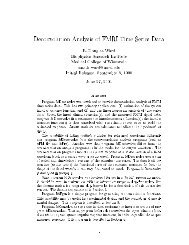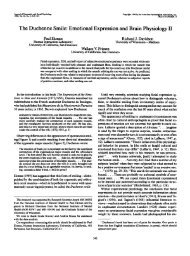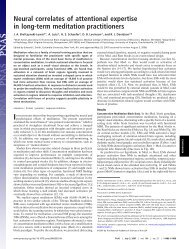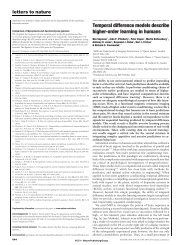l1-magic : Recovery of Sparse Signals via Convex Programming
l1-magic : Recovery of Sparse Signals via Convex Programming
l1-magic : Recovery of Sparse Signals via Convex Programming
Create successful ePaper yourself
Turn your PDF publications into a flip-book with our unique Google optimized e-Paper software.
In a nutshell, the primal dual algorithm finds the optimal z ⋆ (along with optimal dual vectors<br />
ν ⋆ and λ ⋆ ) by solving this system <strong>of</strong> nonlinear equations. The solution procedure is the classical<br />
Newton method: at an interior point (z k , ν k , λ k ) (by which we mean f i (z k ) < 0, λ k > 0), the<br />
system is linearized and solved. However, the step to new point (z k+1 , ν k+1 , λ k+1 ) must be<br />
modified so that we remain in the interior.<br />
In practice, we relax the complementary slackness condition λ i f i = 0 to<br />
λ k i f i (z k ) = −1/τ k , (2)<br />
where we judiciously increase the parameter τ k as we progress through the Newton iterations.<br />
This biases the solution <strong>of</strong> the linearized equations towards the interior, allowing a smooth, welldefined<br />
“central path” from an interior point to the solution on the boundary (see [15,20] for an<br />
extended discussion).<br />
The primal, dual, and central residuals quantify how close a point (z, ν, λ) is to satisfying (KKT )<br />
with (2) in place <strong>of</strong> the slackness condition:<br />
r dual = c 0 + A T 0 ν + ∑ i<br />
λ i c i<br />
r cent = −Λf − (1/τ)1<br />
r pri = A 0 z − b,<br />
where Λ is a diagonal matrix with (Λ) ii = λ i , and f = ( f 1 (z) . . . f m (z) ) T<br />
.<br />
From a point (z, ν, λ), we want to find a step (∆z, ∆ν, ∆λ) such that<br />
r τ (z + ∆z, ν + ∆ν, λ + ∆λ) = 0. (3)<br />
Linearizing (3) with the Taylor expansion around (z, ν, λ),<br />
⎛<br />
r τ (z + ∆z, ν + ∆ν, λ + ∆λ) ≈ r τ (z, ν, λ) + J rτ (z, νλ) ⎝ ∆z ⎞<br />
∆ν⎠ ,<br />
∆λ<br />
where J rτ (z, νλ) is the Jacobian <strong>of</strong> r τ , we have the system<br />
⎛<br />
⎝ 0 ⎞ ⎛ ⎞ ⎛<br />
AT 0 C T ∆z<br />
−ΛC 0 −F ⎠ ⎝∆v⎠ = − ⎝ c 0 + A T 0 ν + ∑ i λ ⎞<br />
ic i<br />
−Λf − (1/τ)1 ⎠ ,<br />
A 0 0 0 ∆λ<br />
A 0 z − b<br />
where m × N matrix C has the c T i as rows, and F is diagonal with (F ) ii = f i (z). We can<br />
eliminate ∆λ using:<br />
∆λ = −ΛF −1 C∆z − λ − (1/τ)f −1 (4)<br />
leaving us with the core system<br />
(<br />
−C T F −1 ΛC A T 0<br />
A 0 0<br />
) ( ) ∆z<br />
=<br />
∆ν<br />
(<br />
−c0 + (1/τ)C T f −1 − A T 0 ν<br />
b − A 0 z<br />
)<br />
. (5)<br />
With the (∆z, ∆ν, ∆λ) we have a step direction. To choose the step length 0 < s ≤ 1, we ask<br />
that it satisfy two criteria:<br />
1. z + s∆z and λ + s∆λ are in the interior, i.e. f i (z + s∆z) < 0, λ i > 0 for all i.<br />
2. The norm <strong>of</strong> the residuals has decreased sufficiently:<br />
‖r τ (z + s∆z, ν + s∆ν, λ + s∆λ)‖ 2 ≤ (1 − αs) · ‖r τ (z, ν, λ)‖ 2 ,<br />
where α is a user-sprecified parameter (in all <strong>of</strong> our implementations, we have set α = 0.01).<br />
4




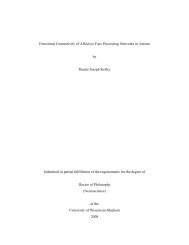
![[F-18]-L-DOPA PET scan shows loss of dopaminergic neurons](https://img.yumpu.com/41721684/1/190x146/f-18-l-dopa-pet-scan-shows-loss-of-dopaminergic-neurons.jpg?quality=85)
